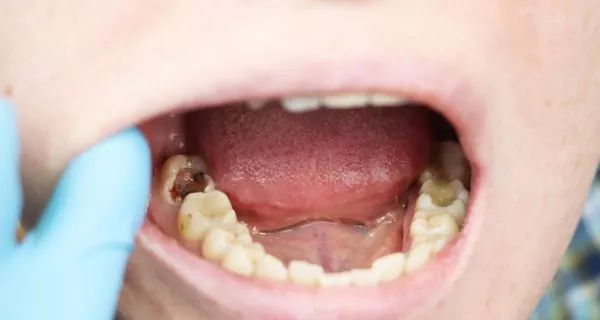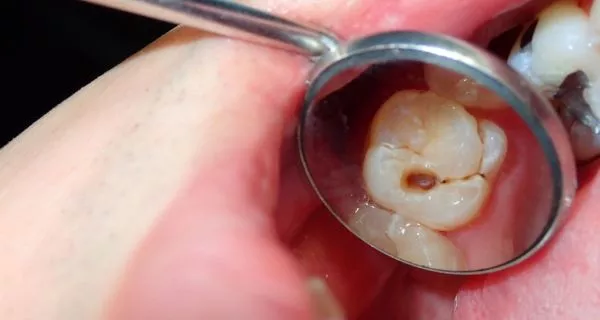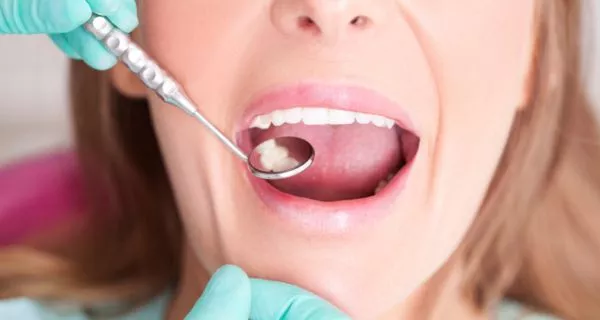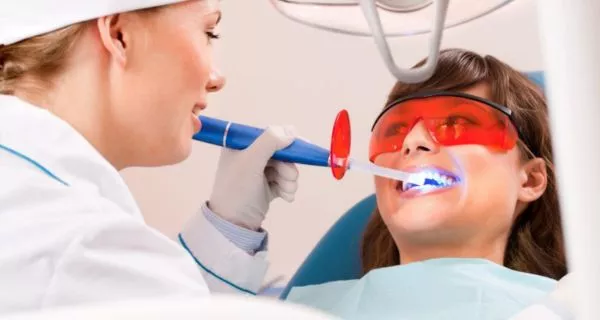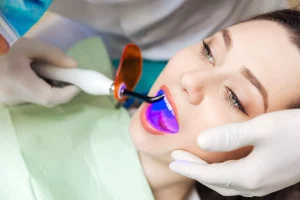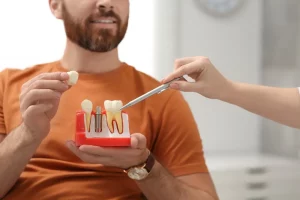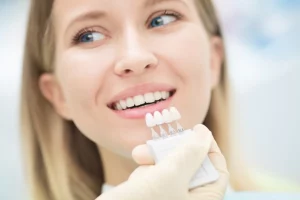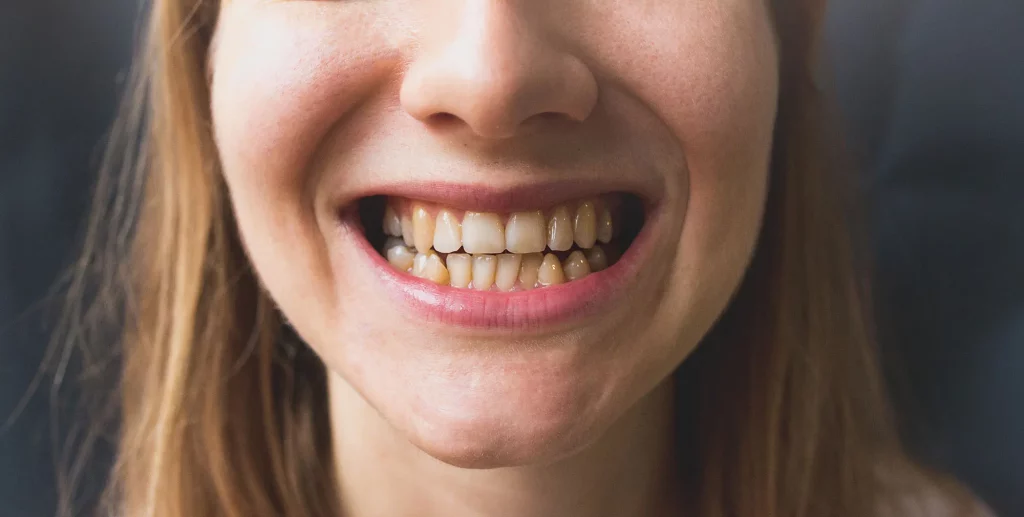Last Updated on: 12th December 2025, 08:06 am
Cavities do not go away on their own. In very early stages, good oral care and fluoride can stop or reverse the damage. But once the enamel breaks, only a dentist can repair it. Regular dental visits are the best way to prevent cavities and keep your teeth healthy.
Many people still wonder, “Will cavities go away?”, and this is a very common myth in dentistry.
It’s true that in some early cases, tooth decay can be stopped. However, once a cavity becomes deeper, it cannot stop by itself; it keeps growing and gets worse over time.
Let’s see how cavities start, how they grow, and what you can do to stop them.
Table of Contents
ToggleWhat are cavities and how do they form?
Cavities, or tooth decay, are small holes that develop when acids slowly break down the enamel. This process doesn’t happen by chance; it depends on three main factors, known as the Keyes Triad: bacteria, sugar, and time.
And of course, there must be teeth, because without teeth, cavities simply can’t exist.
What do bacteria do?
Our mouths are full of bacteria.
- Some bacteria are harmless, but others, like Streptococcus mutans, feed on sugars and produce acid.
- That acid removes minerals from the tooth surface and starts the decay process.
How does sugar affect your teeth?
Bacteria need sugar to survive.
- Every time we eat sweets, bread, or other carbs, bacteria use them as fuel to make more acid.
- The more sugar you eat, the more acid is produced, and the faster enamel wears away.
Why is time important?
The longer acids stay on your teeth, the more damage they cause.
- If you don’t brush and floss often, the acids keep attacking your enamel.
- Over time, this creates small holes that grow deeper and turn into cavities.
If you have weak enamel or a dry mouth, you can get cavities more easily. Saliva helps clean your mouth and repair early damage, so when there’s not enough, your teeth are less protected.
How can you recognize a cavity in its early stage?
Cavities don’t appear overnight; they develop slowly, step by step.
Understanding each stage helps you notice the warning signs before the damage gets serious.
Stage 1: Demineralization (white spot)
This is the very first stage of tooth decay.
- The enamel begins to lose minerals, and a white or chalky spot may appear on the tooth surface.
- There’s usually no pain yet, and the process is still reversible.
- Improving brushing habits, reducing sugar, or using fluoride can stop the decay here and protect your smile.
Stage 2: Enamel decay
The white spot turns yellow or light brown as the enamel breaks down.
- A small hole or surface defect may form.
- You might feel mild sensitivity to cold, heat, or sweets.
- Some people also begin to notice bad breath or a strange taste, caused by bacterial activity inside the cavity.
- At this point, the damage cannot heal on its own, and you should visit your dentist for a filling.
Stage 3: Dentin decay
Now the cavity reaches the dentin, the softer layer beneath the enamel.
- You may feel pain or sensitivity when chewing or drinking something hot or cold.
- The cavity becomes darker and larger, and the decay spreads faster if untreated.
Stage 4: Pulp involvement (pulpitis)
The infection reaches the pulp, which contains the nerve and blood vessels of the tooth.
- Pain becomes strong, constant, and throbbing, sometimes radiating to the jaw or ear.
- Swelling or gum tenderness can appear.
- At this stage, a root canal is usually needed to save the tooth.
Stage 5: Abscess formation
If the infection continues, bacteria can form an abscess (a pocket of pus) near the tooth root.
- This causes severe pain, swelling, and sometimes fever.
- The infection can spread to nearby tissues or even the bone.
- Immediate dental care is needed, sometimes with antibiotics, a root canal, or extraction.
Why does early detection matter?
Cavities may start small and painless, but they never stop on their own. The earlier you catch them, the simpler and less costly the treatment will be.
If you notice white spots, sensitivity, or dark areas, schedule a dental visit right away and take action before the decay gets worse.
Can cavities go away?
Many people wonder, “Will cavities go away?” The truth is that once a real hole forms, cavities cannot heal on their own.
However, if the decay is caught early, before the enamel fully breaks down, it can still be stopped and even reversed with proper treatment.
What are the professional treatments for cavities?
Cavities always need professional attention, but the treatment depends on how advanced they are.
How dentists treat early cavities
When decay only affects the outer enamel, dentists use fluoride treatments to help the tooth repair itself.
Professional fluoride treatments may include:
- Fluoride varnishes or gels: Applied directly to the teeth during your dental visit to strengthen weak enamel.
- Prescription toothpaste: Contains a higher concentration of fluoride than store-bought options to support daily remineralization.
- Fluoride rinses: Used at home to keep enamel resistant to acid attacks and reduce bacterial growth.
These treatments work by attracting essential minerals like calcium and phosphate back into the enamel, a natural repair process called remineralization.
How dentists treat advanced cavities
When decay progresses beyond the enamel and reaches the dentin or pulp, it can no longer heal naturally. At this stage, dentists must remove the damaged tissue and restore the tooth to stop the infection and prevent further damage.
Depending on how deep the cavity is, your dentist may recommend:
- Dental fillings: For small or moderate cavities. The dentist removes the decayed area and fills the space with a tooth-colored resin to restore shape and function.
- Inlays or onlays: Custom-made restorations for larger cavities that are too big for a simple filling but don’t yet need a crown.
- Crowns: Recommended when a large portion of the tooth is damaged. A crown covers the entire tooth, restoring its appearance, strength, and protection.
- Root canal treatment: Needed when decay reaches the pulp or nerve. The infected tissue is removed, the inside of the tooth is cleaned and sealed, and a crown is placed to prevent reinfection.
Advanced cavities require professional treatment to eliminate infection, relieve pain, and restore the tooth’s health and function.
Preventive dental care
Even before a cavity begins, preventive care is the best way to protect your teeth and avoid decay. Good daily habits and regular checkups help keep your enamel strong and bacteria under control.
Dentists use several preventive treatments to keep your smile healthy:
- Fluoride applications: Strengthen enamel and make teeth more resistant to acid attacks.
- Dental sealants: Thin protective coatings applied to the chewing surfaces of molars, where food and bacteria often hide.
- Professional cleanings: Remove plaque, tartar, and bacteria from areas your toothbrush can’t reach.
Professional treatments don’t just fix existing cavities; they stop decay, restore strength, and protect your teeth from future damage.
Still, the best way to fight cavities is to prevent them before they start, and that begins with what you do at home every day.
What can you do at home to prevent cavities?
Even though cavities won’t go away on their own, you can stop new ones from forming and protect your teeth every day with simple habits.
Here’s what really helps:
- Brush twice a day with fluoride toothpaste (at least 1100 ppm).
- Floss daily to remove food and plaque between teeth.
- Rinse with a fluoride or antibacterial mouthwash.
- Limit sugary and acidic foods, especially sticky snacks and soda.
- Drink plenty of water to wash away acids and keep saliva flowing.
- Eat calcium-rich foods like dairy, fish, and leafy greens to strengthen your enamel.
These small daily steps help your teeth stay strong and cavity-free. But remember, once a cavity forms, only your dentist can remove the decay and restore your tooth.
Why are regular dental checkups important?
Cavities often start without pain, so they can go unnoticed. Regular checkups help your dentist detect problems early, before they become serious or expensive.
At Channel Islands Family Dental Office, we recommend visiting every six months for:
- A full exam and X-rays to find early decay.
- Professional cleaning to remove plaque and tartar.
- Fluoride application to strengthen enamel.
- Check the health of your gums and bones.
Regular visits help prevent big problems later and keep your smile healthy and bright.
Where can you get local help to prevent cavities?
If you’re looking for a trusted dentist near you, Channel Islands Family Dental Office is here to help.
We proudly serve Oxnard, Santa Paula, Ventura, Port Hueneme, and Newbury Park, offering care for the whole family.
Our team provides complete cavity prevention and treatment, including:
- Fluoride treatments for enamel protection.
- Sealants to prevent decay in hard-to-clean areas.
- Fillings, crowns, or root canals to repair damaged teeth.
- Routine cleanings to maintain overall oral health.
No matter your age, we are here to help you keep your smile strong and free of cavities.
Can cavities go away on their own?
Many people ask, “Will cavities go away?” The truth is that cavities do not heal on their own. But if you find them early, they can be stopped and repaired before they get worse.
With good daily care and regular dentist visits, you can protect your teeth and avoid painful problems in the future.
At Channel Islands Family Dental Office, our goal is simple: to help you keep your natural teeth healthy and your smile beautiful for life.
Frequently Asked Questions (FAQ)
Voice Search Snippets (Q&A)
References
1. CDC. (2024, May 15). About cavities (Tooth decay). Oral Health. https://www.cdc.gov/oral-health/about/cavities-tooth-decay.html
2. Lockett, E. (2020, December 10). Can you reverse a cavity? Healthline. https://www.healthline.com/health/can-you-reverse-a-cavity
3. Mayo Clinic. (2023, November 30). Cavities and tooth decay – Diagnosis and treatment. Mayo Clinic. https://www.mayoclinic.org/diseases-conditions/cavities/diagnosis-treatment/drc-20352898
4. MouthHealthy. (n. d). Understanding and preventing cavities. Oral Health Information from the ADA. https://www.mouthhealthy.org/dental-care/how-do-we-prevent-cavities
5. Seladi, S. J. (2020, July 30). The Stages of tooth Decay: What they look like. Healthline. https://www.healthline.com/health/dental-and-oral-health/tooth-decay-stages

